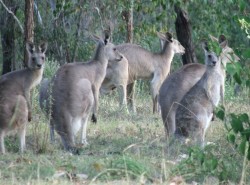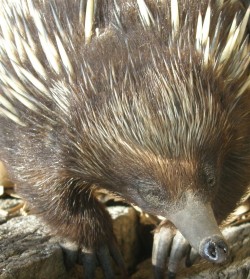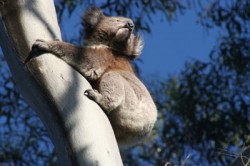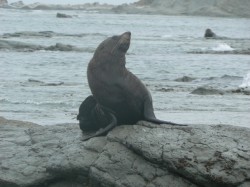MAMMALS

Eastern grey kangaroos (courtesy Darren Green, Araucaria Ecotours)
….kangaroos, koalas, platypus, bats, whales etc
Mammals are milk-giving, lung-breathing vertebrates, and most (apart from whales and dolphins) are hairy.
Australia’s mammalian wildlife is very different from the rest of the world. There are no native hoofed animals, monkeys, cats or bears (and no truly native dogs, although the dingo has apparently been here for at least 3000 years), half of our mammals are marsupials, and we are the only continent with all three of the sub-classes of mammals (see below).
Over 270 species of land dwelling mammals are native to Australia, approximately 84% of these being found nowhere else but the region encompassing Australia, New Guinea and neighbouring islands. Koala, wombat, kangaroo, numbat, platypus and many others are found only in Australia itself, while New Guinea has a number of wallaby, tree kangaroo,bandicoot and other marsupials, plus other species of echidna
Australia and New Guinea (which at times have been joined by land-bridges) are the only countries where all three sub-classes of mammal can still be found:
- Monotremes – egg-laying mammals
- Marsupials – young are born tiny and very undeveloped except for mouth, digestive system and arms for climbing immediately to the mother’s nipple, onto which they latch firmly for a few weeks, inside a pouch or protected by skin-flaps
- Placentals – includes most of the world’s mammals: nourished by a placenta before birth, and born at a more advanced stage (some are blind and hairless at first and unable to walk, others can walk or swim almost immediately), and just visit the mother’s nipple when they need a feed
1. Monotremes
Egg-laying mammals nowadays occur only in Australia and New Guinea, although they were more widespread in the Cretaceous.
The most famous is the platypus, found only in Australia. No one believed the first specimens collected by sailors were genuine, it was such a bizarre animal to look at – and that was before they knew it also laid eggs, despite being furry and giving milk to its offspring, that locate its prey or that the male had a venomous spur (thus being the world’s only venomous mammal).
There is one species of echidna in Australia, which occurs also in New Guinea along with a couple of other species. They are spiny, but they are not related to porcupines or hedgehogs and are very different (they lay eggs, develop pouches for their babies, and use their long sticky tongues to feed on ants and termites). Their closest living relative is of course the platypus.
Monotremes are of great biological interest, as they are the only mammals that lay eggs as well as having true mammalian hair and suckling their young with milk, and share various other oddities.
Where to see them
Platypus are found in rivers and streams of eastern Australia, from north Queensland to Tasmania, and introduced to Kangaroo Island, South Australia. They can be seen in a number of wildlife parks and zoos, including David Fleay Wildlife Park (Qld), Lone Pine Sanctuary (Qld), Taraonga Zoo (NSW), Healesville Sanctuary (Vic) and Platypus House (Tas). They can often be seen on tour with Araucaria Ecotours (Qld)
Echidnas are found throughout Australia but can be very unpredictable. They can be seen in captivity in Currumbin Wildlife Sanctuary (Qld), Australia Zoo (Qld), Platypus House (Tas), Wings Wildlife Park (Tas) and various other zoos and wildlife parks.
2. Marsupials
Marsupials have a number of unusual features, the most famous being the use of a pouch to carry the young, which is most conspicuous in the kangaroo family. Burrowing and tree-climbing marsupials generally have a backward-facing pouch, and in several small carnivorous species it is reduced to just a fold of skin. Young are born at a very immature stage, and climb to the pouch where they attach firmly to their mother’s teats for several weeks. Approximately half of Australia’s mammals are marsupials.
Australian marsupials are divided into four orders:
- Diprotodonta, meaning ‘two front teeth’. These mainly herbivorous animals include about 80 species, the most well-known are mammals including kangaroos, koalas, wombats and possums.
- Dasyuromorphia. These carnivorous animals include the well-known Tasmanian Devil and about 50 other species of smaller animals. The largest mainland species is the spotted-tailed quoll.
- Peramelemorphia. These omnivorous animals include the bilby and seven species of bandicoot.
- Notoryctemorphia. This is a single species called a marsupial “mole”, completely unrelated to the placental moles and unique to Australia. It is very rarely seen, living below ground in the outback.
Where to see them.
Kangaroos and wallabies are found throughout Australia. The famous big red kangaroo is a creature of the outback, but the greys are in coastal forests. A great site to find where to see this family (and the related potoroo family) is rootourism. Tree kangaroos are confined to northern Queensland and New Guinea, but can be seen in Currumbin Wildlife Sanctuary (Qld), David Fleay Wildlife Park (Qld) and a few other captive settings. Quokas are confined to Rottnest Island, Western Australia. Musky rat-kangarros, belonging to a separate but related family, are confined to rain forests of far northern Australia, and unlike most Australian mammals are active during the day.
Koalas occur in the wild in eucalpt forests and woodlands of eastern Australia, and have been introduced to the Adelaide Hills and Kangaroo Island (SA) after becoming extinct in SA in the 1920’s. Echidna Walkabout lead tours that include finding individual animals for on-going research.
Koalas, kangaroos, wallabies, wombats and Tasmanian Devils can be seen in many zoos and wildlife parks, such as Cleland Wildlife Park, and Currumbin Wildlife Sanctuary.
Common brush-tailed possums and common ring-tailed possums are often seen at night even in our cities, and on many spotlighting visits to forests. Other possums, gliders, bandicoots and other nocturnal creatures can often be seen on tour with knowledgable guides. The endangered mahogany glider can be seen at the Davd Fleay WIldlife Park.
Numbats can be seen in the Perth Zoo and Cleland Wildlife Park. Various other marsupials are on display in other zoos and wildlife parks.
Also visit Tips for watching kangaroos and wallabies
3. Placentals.
Young grow inside the mother’s uterus to a relatively advanced stage of development. Most of the world’s mammals belong to this group. Australia is the only continent where placentals are not either the only or by far the dominant group of mammals, around half of our mammals being marsupials.
Native terrestrial placental species are almost evenly divided between:
- Rodents accounting for 22% of Australian mammal species are all in the rat and mouse family, Muridae. Their ancestors came from the north in several waves probably from about 4 million years ago.
- Bats and make another 22% of Australian mammal species. The megabats, such as the flying fox, the tube-nosed bats and blossom bats lack echolocation and feed on fruit or nectar or both. The microbats are small, echo locating insectivorous bats – although some also eat frogs, mice and even other bats.
In addition there are a number of marine mammals: whales, dolphins, dugongs, seals and sea lions.
There are a number of mammals that have been introduced by humans and become well-established in the wild. The longest established is the dingo, brought to Australia perhaps 4000 years ago by Indonesian traders. More recently foxes, cats, rabbits, hares, horses, donkeys, cattle, buffalo, goats, camels, pigs, several species of deer and three species of rodent have been introduced.
Where to see them.
Dugongs are found in coastal waters from Brisbane northwards, across the Top End and then southwest to a similar latitude. The Tangalooma Eco-cruise is one way of getting a glimpse of them as they surface for air. They are not as easily spotted as dolphins, as they don’t leap from the water.
Humpback whales travel the eastern and western coasts of Australia in the cooler months, and southern right whales visit the southern coasts, and there are many whale-watching tours.Minke whales visit the northern Great Barrier Reef during the winter months (May-August) and during this time show a keen interest in boats and people. See also http://www.australianwhalewatching.com.au/
Dolphins are often readily seen from the coast or a boat. Bottlenose dolphins abound in many coastal areas, the IndoPacific humpback dolphin at Tin Can Bay, Qld, and a few other sites.
Fur seals and sea-lions are readily seen on Kangaroos Island, Tasmania and parts of the mainland’s south coast, including southwestern Western Australia (e.g. Rottnest Island), South Australia Victoria and southeastern NSW.
Fruitbat colonies – with large, noisy bats hanging conspicuously from the trees, are found in many areas of eastern and northern Australia. Smaller bats (the insects-eating echolocating micro bats) are numerous and diverse, and found throughout Australia, but generally not so easy to se except in a few tourist caves, or when flitting around treetops, over water or above desert shrublands at dusk.
Bush rats and other native rodents are common in some campgrounds. Native rodents generally are common throughout most habitats away from the cities (where introduced mice and rats predominate) but are small and nocturnal so difficult to see, and there are a few rare and endangered species. Water rats may sometimes be seen resting on logs or creek banks at night, but you need a lot of patience! Some rodents can be seen in captivity (e.g. hopping mice and Plains rats at the David Fleay Wildlife Park, Queensland).
MAMMALS

Eastern grey kangaroos (courtesy Darren Green, Araucaria Ecotours)
….kangaroos, koalas, platypus, bats, whales etc
Mammals are milk-giving, lung-breathing vertebrates, and most (apart from whales and dolphins) are hairy.
Australia’s mammalian wildlife is very different from the rest of the world. There are no native hoofed animals, monkeys, cats or bears (and no truly native dogs, although the dingo has apparently been here for at least 3000 years), half of our mammals are marsupials, and we are the only continent with all three of the sub-classes of mammals (see below).
Over 270 species of land dwelling mammals are native to Australia, approximately 84% of these being found nowhere else but the region encompassing Australia, New Guinea and neighbouring islands. Koala, wombat, kangaroo, numbat, platypus and many others are found only in Australia itself, while New Guinea has a number of wallaby, tree kangaroo,bandicoot and other marsupials, plus other species of echidna
Australia and New Guinea (which at times have been joined by land-bridges) are the only countries where all three sub-classes of mammal can still be found:
- Monotremes – egg-laying mammals
- Marsupials – young are born tiny and very undeveloped except for mouth, digestive system and arms for climbing immediately to the mother’s nipple, onto which they latch firmly for a few weeks, inside a pouch or protected by skin-flaps
- Placentals – includes most of the world’s mammals: nourished by a placenta before birth, and born at a more advanced stage (some are blind and hairless at first and unable to walk, others can walk or swim almost immediately), and just visit the mother’s nipple when they need a feed
1. Monotremes
Egg-laying mammals nowadays occur only in Australia and New Guinea, although they were more widespread in the Cretaceous.
The most famous is the platypus, found only in Australia. No one believed the first specimens collected by sailors were genuine, it was such a bizarre animal to look at – and that was before they knew it also laid eggs, despite being furry and giving milk to its offspring, that locate its prey or that the male had a venomous spur (thus being the world’s only venomous mammal).
There is one species of echidna in Australia, which occurs also in New Guinea along with a couple of other species. They are spiny, but they are not related to porcupines or hedgehogs and are very different (they lay eggs, develop pouches for their babies, and use their long sticky tongues to feed on ants and termites). Their closest living relative is of course the platypus.
Monotremes are of great biological interest, as they are the only mammals that lay eggs as well as having true mammalian hair and suckling their young with milk, and share various other oddities.
Where to see them
Platypus are found in rivers and streams of eastern Australia, from north Queensland to Tasmania, and introduced to Kangaroo Island, South Australia. They can be seen in a number of wildlife parks and zoos, including David Fleay Wildlife Park (Qld), Lone Pine Sanctuary (Qld), Taraonga Zoo (NSW), Healesville Sanctuary (Vic) and Platypus House (Tas). They can often be seen on tour with Araucaria Ecotours (Qld)
Echidnas are found throughout Australia but can be very unpredictable. They can be seen in captivity in Currumbin Wildlife Sanctuary (Qld), Australia Zoo (Qld), Platypus House (Tas), Wings Wildlife Park (Tas) and various other zoos and wildlife parks.
2. Marsupials
Marsupials have a number of unusual features, the most famous being the use of a pouch to carry the young, which is most conspicuous in the kangaroo family. Burrowing and tree-climbing marsupials generally have a backward-facing pouch, and in several small carnivorous species it is reduced to just a fold of skin. Young are born at a very immature stage, and climb to the pouch where they attach firmly to their mother’s teats for several weeks. Approximately half of Australia’s mammals are marsupials.
Australian marsupials are divided into four orders:
- Diprotodonta, meaning ‘two front teeth’. These mainly herbivorous animals include about 80 species, the most well-known are mammals including kangaroos, koalas, wombats and possums.
- Dasyuromorphia. These carnivorous animals include the well-known Tasmanian Devil and about 50 other species of smaller animals. The largest mainland species is the spotted-tailed quoll.
- Peramelemorphia. These omnivorous animals include the bilby and seven species of bandicoot.
- Notoryctemorphia. This is a single species called a marsupial “mole”, completely unrelated to the placental moles and unique to Australia. It is very rarely seen, living below ground in the outback.
Where to see them.
Kangaroos and wallabies are found throughout Australia. The famous big red kangaroo is a creature of the outback, but the greys are in coastal forests. A great site to find where to see this family (and the related potoroo family) is rootourism. Tree kangaroos are confined to northern Queensland and New Guinea, but can be seen in Currumbin Wildlife Sanctuary (Qld), David Fleay Wildlife Park (Qld) and a few other captive settings. Quokas are confined to Rottnest Island, Western Australia. Musky rat-kangarros, belonging to a separate but related family, are confined to rain forests of far northern Australia, and unlike most Australian mammals are active during the day.
Koalas occur in the wild in eucalpt forests and woodlands of eastern Australia, and have been introduced to the Adelaide Hills and Kangaroo Island (SA) after becoming extinct in SA in the 1920’s. Echidna Walkabout lead tours that include finding individual animals for on-going research.
Koalas, kangaroos, wallabies, wombats and Tasmanian Devils can be seen in many zoos and wildlife parks, such as Cleland Wildlife Park, and Currumbin Wildlife Sanctuary.
Common brush-tailed possums and common ring-tailed possums are often seen at night even in our cities, and on many spotlighting visits to forests. Other possums, gliders, bandicoots and other nocturnal creatures can often be seen on tour with knowledgable guides. The endangered mahogany glider can be seen at the Davd Fleay WIldlife Park.
Numbats can be seen in the Perth Zoo and Cleland Wildlife Park. Various other marsupials are on display in other zoos and wildlife parks.
Also visit Tips for watching kangaroos and wallabies
3. Placentals.
Young grow inside the mother’s uterus to a relatively advanced stage of development. Most of the world’s mammals belong to this group. Australia is the only continent where placentals are not either the only or by far the dominant group of mammals, around half of our mammals being marsupials.
Native terrestrial placental species are almost evenly divided between:
- Rodents accounting for 22% of Australian mammal species are all in the rat and mouse family, Muridae. Their ancestors came from the north in several waves probably from about 4 million years ago.
- Bats and make another 22% of Australian mammal species. The megabats, such as the flying fox, the tube-nosed bats and blossom bats lack echolocation and feed on fruit or nectar or both. The microbats are small, echo locating insectivorous bats – although some also eat frogs, mice and even other bats.
In addition there are a number of marine mammals: whales, dolphins, dugongs, seals and sea lions.
There are a number of mammals that have been introduced by humans and become well-established in the wild. The longest established is the dingo, brought to Australia perhaps 4000 years ago by Indonesian traders. More recently foxes, cats, rabbits, hares, horses, donkeys, cattle, buffalo, goats, camels, pigs, several species of deer and three species of rodent have been introduced.
Where to see them.
Dugongs are found in coastal waters from Brisbane northwards, across the Top End and then southwest to a similar latitude. The Tangalooma Eco-cruise is one way of getting a glimpse of them as they surface for air. They are not as easily spotted as dolphins, as they don’t leap from the water.
Humpback whales travel the eastern and western coasts of Australia in the cooler months, and southern right whales visit the southern coasts, and there are many whale-watching tours.Minke whales visit the northern Great Barrier Reef during the winter months (May-August) and during this time show a keen interest in boats and people. See also http://www.australianwhalewatching.com.au/
Dolphins are often readily seen from the coast or a boat. Bottlenose dolphins abound in many coastal areas, the IndoPacific humpback dolphin at Tin Can Bay, Qld, and a few other sites.
Fur seals and sea-lions are readily seen on Kangaroos Island, Tasmania and parts of the mainland’s south coast, including southwestern Western Australia (e.g. Rottnest Island), South Australia Victoria and southeastern NSW.
Fruitbat colonies – with large, noisy bats hanging conspicuously from the trees, are found in many areas of eastern and northern Australia. Smaller bats (the insects-eating echolocating micro bats) are numerous and diverse, and found throughout Australia, but generally not so easy to se except in a few tourist caves, or when flitting around treetops, over water or above desert shrublands at dusk.
Bush rats and other native rodents are common in some campgrounds. Native rodents generally are common throughout most habitats away from the cities (where introduced mice and rats predominate) but are small and nocturnal so difficult to see, and there are a few rare and endangered species. Water rats may sometimes be seen resting on logs or creek banks at night, but you need a lot of patience! Some rodents can be seen in captivity (e.g. hopping mice and Plains rats at the David Fleay Wildlife Park, Queensland).




I have a kangaroo myself. Great information
nnwpznwwfqpuuntjmrkbxrtnqotuya
Disappointed in your descriptions of mammals and the omission of the dingo. While some will argue that the dingo is an introduced animal the majority of ecologists including Prof Chris Johnson and Prof Tim Flannery argue that as it has been part of the Australian ecosystem for from 3500 to 5000 years it must be considered indigenous. Also, it has been recognized in Victoria as a threatened species, and is now protected in Victoria. Given that your conference is being hosted in Victoria it would be a ‘good look’ for international visitors to have the place of the dingo acknowledged on your wen site.
It’s a product of too much to do and too little time by overworked unpaid volunteers (including our committee) writing these pages! We do intend adding in the dingo, explaining its probable mode of entry into Australia and other details. You are right that although introduced by humans it has been here a long time, and probably now to some extent substitutes for extinct mammalian predators such as Thylacine and Thylacoleo
There are also many other species we’ve yet to include but certainly intend dong so.